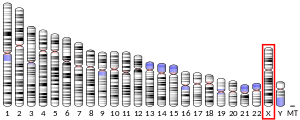IQSEC2
IQ motif and Sec7 domain 2 is a protein that in humans is encoded by the IQSEC2 gene.[5][6]
Function
The IQSEC2 gene encodes a guanine nucleotide exchange factor for the ARF family of GTP-binding proteins (see for example ARF1).[7]
Clinical significance
It is associated with X-Linked mental retardation 1.[7]
gollark: You could use that, I think, but it is the wrong explanation.
gollark: In the background is a "crab".
gollark: Your explanation is wrong, this is an extra utilities "screen".
gollark: Then explain THIS:
gollark: Because if I was, then that would mean that I would be, but I am not.
References
- GRCh38: Ensembl release 89: ENSG00000124313 - Ensembl, May 2017
- GRCm38: Ensembl release 89: ENSMUSG00000041115 - Ensembl, May 2017
- "Human PubMed Reference:". National Center for Biotechnology Information, U.S. National Library of Medicine.
- "Mouse PubMed Reference:". National Center for Biotechnology Information, U.S. National Library of Medicine.
- "Entrez Gene: IQ motif and Sec7 domain 2".
- Nagase T, Ishikawa K, Miyajima N, Tanaka A, Kotani H, Nomura N, Ohara O (February 1998). "Prediction of the coding sequences of unidentified human genes. IX. The complete sequences of 100 new cDNA clones from brain which can code for large proteins in vitro". DNA Res. 5 (1): 31–9. doi:10.1093/dnares/5.1.31. PMID 9628581.
- Shoubridge C, Tarpey PS, Abidi F, Ramsden SL, Rujirabanjerd S, Murphy JA, Boyle J, Shaw M, Gardner A, Proos A, Puusepp H, Raymond FL, Schwartz CE, Stevenson RE, Turner G, Field M, Walikonis RS, Harvey RJ, Hackett A, Futreal PA, Stratton MR, Gécz J (June 2010). "Mutations in the guanine nucleotide exchange factor gene IQSEC2 cause nonsyndromic intellectual disability". Nat. Genet. 42 (6): 486–8. doi:10.1038/ng.588. PMC 3632837. PMID 20473311.
Further reading
- Ross MT, Grafham DV, Coffey AJ, et al. (2005). "The DNA sequence of the human X chromosome". Nature. 434 (7031): 325–37. Bibcode:2005Natur.434..325R. doi:10.1038/nature03440. PMC 2665286. PMID 15772651.
- Ota T, Suzuki Y, Nishikawa T, et al. (2004). "Complete sequencing and characterization of 21,243 full-length human cDNAs". Nat. Genet. 36 (1): 40–5. doi:10.1038/ng1285. PMID 14702039.
- Filippova GN, Cheng MK, Moore JM, et al. (2005). "Boundaries between chromosomal domains of X inactivation and escape bind CTCF and lack CpG methylation during early development". Dev. Cell. 8 (1): 31–42. doi:10.1016/j.devcel.2004.10.018. PMID 15669143.
- Cox R, Mason-Gamer RJ, Jackson CL, Segev N (2004). "Phylogenetic analysis of Sec7-domain-containing Arf nucleotide exchangers". Mol. Biol. Cell. 15 (4): 1487–505. doi:10.1091/mbc.E03-06-0443. PMC 379250. PMID 14742722.
- Dosemeci A, Makusky AJ, Jankowska-Stephens E, et al. (2007). "Composition of the synaptic PSD-95 complex". Mol. Cell. Proteomics. 6 (10): 1749–60. doi:10.1074/mcp.M700040-MCP200. PMC 2096750. PMID 17623647.
- Tsuchiya KD, Greally JM, Yi Y, et al. (2004). "Comparative sequence and x-inactivation analyses of a domain of escape in human xp11.2 and the conserved segment in mouse". Genome Res. 14 (7): 1275–84. doi:10.1101/gr.2575904. PMC 442142. PMID 15197169.
- Strausberg RL, Feingold EA, Grouse LH, et al. (2002). "Generation and initial analysis of more than 15,000 full-length human and mouse cDNA sequences". Proc. Natl. Acad. Sci. U.S.A. 99 (26): 16899–903. Bibcode:2002PNAS...9916899M. doi:10.1073/pnas.242603899. PMC 139241. PMID 12477932.
- Barbe L, Lundberg E, Oksvold P, et al. (2008). "Toward a confocal subcellular atlas of the human proteome". Mol. Cell. Proteomics. 7 (3): 499–508. doi:10.1074/mcp.M700325-MCP200. PMID 18029348.
- Murphy JA, Jensen ON, Walikonis RS (2006). "BRAG1, a Sec7 domain-containing protein, is a component of the postsynaptic density of excitatory synapses". Brain Res. 1120 (1): 35–45. doi:10.1016/j.brainres.2006.08.096. PMID 17045249.
This article is issued from Wikipedia. The text is licensed under Creative Commons - Attribution - Sharealike. Additional terms may apply for the media files.



